GATE Practice Test: Electrical Engineering (EE)- 1 - Electrical Engineering (EE) MCQ
30 Questions MCQ Test - GATE Practice Test: Electrical Engineering (EE)- 1
Choose the most approximate word from the options given below to complete the following sentence.
If I had known that you were coming, I _______ you at the airport
Choose the most approximate word from the options given below to complete the following sentence.
I believe in the _____ of positive thinking thus always recommend these books to my clients.
Consider a circle of radius r. Fit the largest possible square inside it and the largest possible circle inside the square. What is the radius of the innermost circle?
A bird files along the three sides of a field in the shape of an equilateral triangle at speeds of 3, 6, 8 km/hr respectively. The average speed of the bird is
Choose the most appropriate words from the options given below to fill in the blanks.
She was ______ to travel abroad and _____ in the field of commerce as per her wishes.
In a 1600 m race around a circular track of length 400 m, the faster runner and the slowest runner meet at the end of the sixth minute, for the first time after the start of the race. All the runners maintain uniform speed throughout the race. If the faster runner runs at twice the speed of the slowest runner. Find the time taken by the faster runner to finish the race.
Select the pair that best expresses a relationship similar to that expressed in the pair:
Horse: Foal
Read the following passage and find out the inference stated through passage.
Juvenile delinquency is also termed as Teenage Crime. Basically, juvenile delinquency refers to the crimes committed by minors. These crimes are committed by teenagers without any prior knowledge of how it affects the society. These kind of crimes are committed when children do not know much about outside world.
Which of the following Inferences is correct with respect to above passage?
If n and y are positive integers and 450 y = n³, which of the following must be an integer?

The graph shows cumulative frequency % of research scholars and the number of papers published by them. Which of the following statements is true?
For which value of x, the following matrix A is a singular matrix.

Find the laplace transform of t2sin (2t).
Consider the following function:

The integrating factor of equation y log y dx + (x – log y) dy = 0 is
Relationship between input x(t) and output y(t) of a system is given as

The transfer function of this system is
For the two square inputs in figure, the PMMC meter will read, maximum when the phase difference between them is

- For the circuit shown the hybrid parameter matrix [h] is
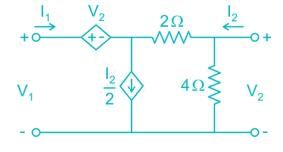
H(z) is discrete rational transfer function. To ensure that both H(z) and its inverse are stable its
In the dc circuit shown in the below figure, the node voltage V2 at steady state is
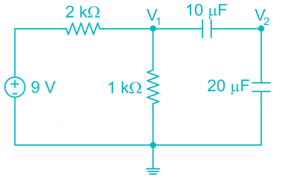
A DC-DC converter is used to feed the resistive load and its output is always inverted. An alternating square wave voltage is getting produced across in inductor having rms value of 200 V and frequency of 50 Hz. the duty cycle of the switch is______
If the multiplexer is controlled such that the channels one sequenced every 5 μs as 1, 2, 1, 3, 1, 4, 1, 2, 1, 3, 1, 4, 1, … , the input connected to channel 1 will be sampled at the rate of
What percentage of current IDSS is the drain current for a JFET, if the gate to source voltage is 65% of the pinch-off voltage.
A uniform line charge of infinite length with PL = 15 nC/m lies along the z-axis.
The electric field at (5, 12, 20) will be – v/m
A three phase, 50 Hz transmission line of length 120 km has a capacitance of  It is represented as a π – model. The shunt admittance at each end of the transmission line will be
It is represented as a π – model. The shunt admittance at each end of the transmission line will be
The fundamental period of the sequence x[n] = 3 sin (1.3 πn + 0.5 π) + 5 sin (1.2 πn) is
What should be the input voltage to turn off the SCR in the circuit shown in figure below when holding current of the SCR is 4 mA and load resistance is 4 kΩ.
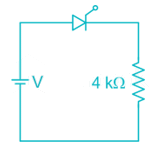
The inverse Fourier transform of a function given 
Figure shows the polar plot of a system. The transfer function of the system is
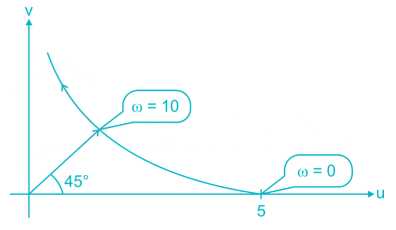
In the circuit of figure A, B, C are the inputs and P, Q are the two outputs. The circuit is a
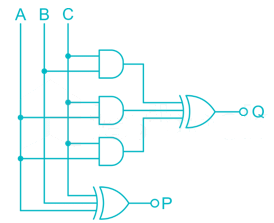










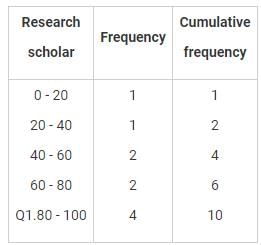



 =
= 





 value of b = ?
value of b = ?







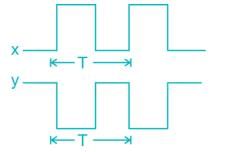

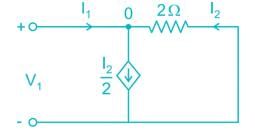








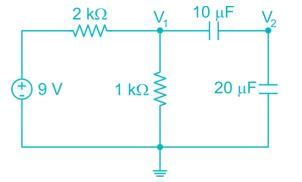


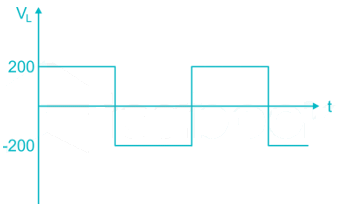

 100k samples/sec
100k samples/sec
 (1−0.65)2 = 0.1225 = 12.25%
(1−0.65)2 = 0.1225 = 12.25% 























